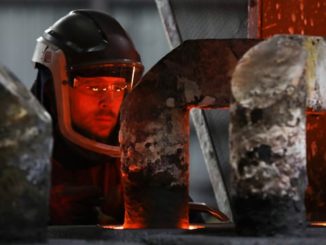
Multimillion dollar project will scan and make public methane leaks from oil and gas plants that are a major contributor to global warming
Methane leaking from oil and gas facilities around the world – a major contributor to global warming – is set to be spotted from space.
The Environmental Defense Fund (EDF) has announced it aims to launch a satellite called MethaneSAT by 2021 to scan the globe and make major leaks public. That information will then enable governments to force action, EDF hopes. Building and launching the satellite will cost tens of millions of dollars, but EDF says it has already raised most of the money.
Methane is a potent greenhouse gas, 80 times more powerful than carbon dioxide in the short term, and is responsible for about a fifth of human-caused climate change. The oil and gas industry is to blame for about a third of anthropogenic methane emissions, from fracking and other exploration sites, and from leaky pipelines.
“Cutting methane emissions from the global oil and gas industry is the single fastest thing we can do to help put the brakes on climate change right now,” said Fred Krupp, EDF president. Only 3% of oil and gas companies currently report quantitative methane emissions, according to EDF. “By providing reliable, fully transparent data on a worldwide scale, MethaneSAT will help transform a serious climate threat into a crucial opportunity,” he said.
Plugging methane leaks is widely seen as a fast, cheap way to tackle climate change. The International Energy Agency (IEA) estimates half of the gas leaks could be stopped at zero cost, because the cost of doing so is offset by the value of the extra gas captured and then sold. But currently public information about the leaks is scarce and near-absent in regions where scrutiny is unwelcome.
“Our analysis has consistently emphasised that an effective response to the problem of methane emissions requires good data,” said Fatih Birol, IEA executive director. “This announcement is a major step forward.”
“To help companies and countries cut these emissions faster, we need better data that will enable quick, cost effective action,” said Erik Solheim, head of UN Environment. “The MethaneSAT project will help fill this gap, and make us that much smarter as we tackle this threat.”
EDF has hiredTom Ingersoll, an aerospace veteran and entrepreneur. “Advances in space technology have put satellite projects within reach of any organisation with the focus and the will,” he said. EDF has also partnered with Harvard University and the Smithsonian Astrophysical Observatory to plan the mission.
Peter Platzer, chief executive of Spire Global, a satellite company that is not involved with the MethaneSAT project, told the New York Times: “I think this is entirely feasible.”
Some existing government-run satellites do measure methane, but not at high enough resolution to identify specific sites clearly. MethaneSAT is intended to provide a new level of precision and to regularly monitor about 50 major oil and gas regions, accounting for more than 80% of global production. Cattle and otherlivestock are also big methane emitters as they digest their fodder and EDF says the new satellite will be able to measure emissions from feedlots.
Visits: 48




Be the first to comment